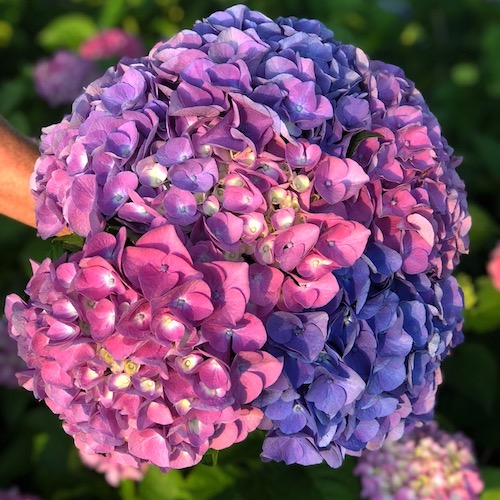Hydrangea – the most popular plant
Hydrangeas are not just another pretty face in the garden; they’re a diverse group of plants known for their large, showy blooms and ability to thrive in a variety of climates. We love our hydrangeas here at Celtic farm, and have created an entire grove of these lovely plants with purple pink and blue blooms. Before we dive into the specific types and their care, let’s cover some hydrangea basics, tips for selecting them at the nursery, and general growing advice.
Hydrangea Basics
Hydrangeas are deciduous shrubs that feature flowers ranging from big, bold mopheads to delicate lacecaps. They generally bloom from early spring to late autumn. Hydrangeas are known for their ability to change flower color from pink to blue based on the soil pH; acidic soils lead to bluer flowers, while alkaline soils yield pinker blooms. (You can read how to change bloom color here – How to change hydrangea color.). Here are the most popular types:
- Hydrangea macrophylla for Bigleaf hydrangeas,
- Hydrangea arborescens for Smooth hydrangeas,
- Hydrangea paniculata for Panicle hydrangeas,
- Hydrangea quercifolia for Oakleaf hydrangeas,
- Hydrangea anomala for Climbing hydrangeas.
Picking Hydrangeas at the Nursery
When at the nursery, look for hydrangeas with healthy, vigorous green leaves and no signs of wilting or disease. Check the root system if possible; roots should be firm and spread out, not circling or cramped. Opt for plants with several buds rather than those in full bloom, as they’ll acclimate better when planted.
General Growing Tips
Hydrangeas prefer well-drained, fertile soil. They benefit from mulching to retain moisture and protect their roots. Most varieties prefer some shade, especially in the afternoon, but some can tolerate and even thrive in full sun, provided they get enough water. Regular pruning keeps the plants healthy, encourages airflow, and can enhance blooming.
Types of Hydrangea
Moving on to the types and their specific requirements:
Bigleaf Hydrangeas prosper in zones 5-9, preferring morning sun and afternoon shade to protect their blooms from scorching.
Smooth Hydrangeas are versatile, doing well in full sun to shade across zones 3-9, making them a flexible choice for various garden locations.
Panicle Hydrangeas are sun-lovers that thrive in zones 3-8, relishing the brightness to produce their signature cone-shaped flowers.
Oakleaf Hydrangeas enjoy zones 5-9 and do best with some sun to develop their distinctive foliage and bloom colors that change as the season heats up.
Lacecap Hydrangeas flourish in zones 5-9 and are partial to shady spots where their intricate flower patterns can be appreciated without the stress of direct sunlight.
Climbing Hydrangeas are perfect for shaded walls in zones 4-7, where they can climb and cascade, adding vertical interest to the garden.
For those looking to expand their hydrangea collection with even more variety, consider these:
Alice Hydrangeas need acidic soil and partial shade in zones 5-9 to reach their impressive heights.
All Summer Beauty maintains its splendor in zones 5-9 with partial shade and well-drained soil, living up to its enduring name..
Amethyst Hydrangeas are a compact choice for zones 5-9, preferring the dappled light of partial shade to showcase their vibrant blooms..
Annabelle Hydrangeas start with green blooms in zones 6-9, turning white as they mature, thriving in the cooler shelter of partial shade..
Avant-Garde Hydrangeas in zones 5-9 need a mix of sun and shade to develop their pink to red blooms.
Beni-Gaku Hydrangeas offer a kaleidoscope of colors in zones 5-9, enjoying the protection of afternoon shade.
Bloomstruck Hydrangeas are sturdy in zones 4-9, requiring several hours of sun and consistent watering.
Bobo Hydrangeas are well-suited for zones 3-8, with a preference for sunny spots that help maintain their white and pink blooms.
In choosing the right hydrangea for your garden, it’s essential to consider the specific needs of each variety, including the climate zone, preferred sunlight exposure, and soil type. With these considerations in mind and proper care, your hydrangeas can become a flourishing feature in your garden, providing a stunning display of blooms through the seasons.












You must be logged in to post a comment.